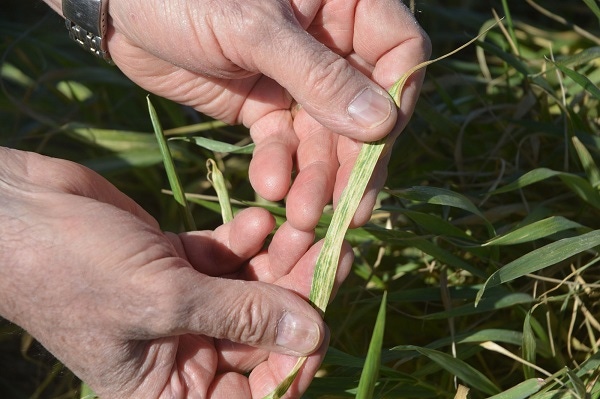May 29, 2014

Texas AgriLife researchers are working on multiple fronts to improve opportunities for wheat production throughout the state. Recent reports from media specialists Kay Ledbetter, Amarillo, and Paul Schattenberg, College Station, highlight work on disease control, variety development and efforts to extend the range of wheat production into new, underutilized areas.
Ledbetter reports on efforts to manage wheat streak mosaic, a common disease that occurs in the Texas Panhandle and Great Plains every year. The disease is not easily distinguishable from drought stress. Misidentification could result in wasted inputs. Knowing when the disease is present will give producers information to make better management decisions in-season, researchers say.
Dr. Charlie Rush, Texas A&M AgriLife Research plant pathologist in Amarillo, and senior research associate, Jacob Price, recently conducted a field day to educate farmers about the impact of wheat streak and other mite-vectored viruses on grain yield.
For the latest on southwest agriculture, please check out Southwest Farm Press Daily and receive the latest news right to your inbox
“We are trying to explain that when plants are infected, they cannot efficiently use the water applied in irrigated situations and they are no longer able to take up nutrients,” Rush said. “We are trying to develop an economic threshold for wheat streak so farmers will know when it is worthwhile for them to try to manage it and get something out of the crop or to make the determination that it is diseased to a point where it is not worth putting on additional inputs.”
Rush said producers sometimes have difficulty differentiating between drought stress and wheat streak mosaic. Read the full report.
New varieties
Ledbetter also reports on two new wheat varieties to be launched by Texas A&M AgriLife Research and the TAM Wheat Improvement Program. TAM 114 and TAM 204 have unique qualities, according to Dr. Jackie Rudd, AgriLife Research wheat breeder at Amarillo.
The announcement of the pending releases was made during the Rolling Plains Spring Field Day and Hardeman County Wheat Field Tour recently at Chillicothe.
“TAM 114 and TAM 204 each have unique characteristics and offer things to producers that we really haven’t had before,” Rudd said.
TAM 114, a hard red winter wheat developed from a cross between TAM 111 and an experimental breeding line, has excellent milling and baking quality, he said.
Read more about new wheat varieties.
Expanding wheat production area
Paul Schattenberg offers a report on efforts to test wheat varieties that may be suitable for “non-traditional” areas of the state.
Wheat is the biggest field crop in Texas in terms of acreage — estimated at about 6 million acres annually by the National Agricultural Statistics Service — but is currently grown mostly in the High Plains and Rolling Plains.
Dr. Mark Welch, Texas A&M AgriLife Extension Service economist in College Station, says wheat is underutilized in other parts of the state and many producers could benefit financially by having it as a primary or rotational crop.
Recently, wheat trials at the Texas A&M AgriLife Research and Extension Center in Uvalde were highlighted at its Combined Wheat and Vegetable Field Day, which introduced area producers to multiple varieties of spring and winter wheat grown under different irrigation rates.
And there is also good potential for wheat production in coastal areas and as far south as the Lower Rio Grande Valley, Welch noted. More on statewide wheat potential.
You May Also Like




